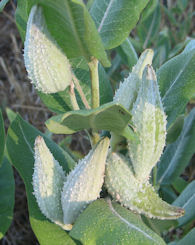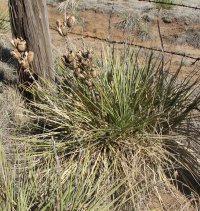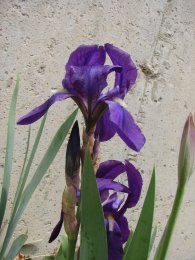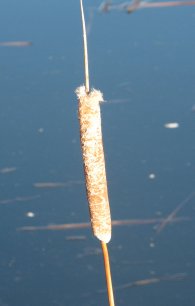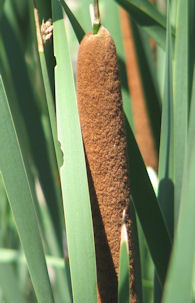| Aspen trees, near Elevenmile Lake, on 29 September 2006.
These trees turn their leaves a bright yellow in late September or early October.
If there has been a drought, they will turn a dull yellow.
Kingdom: Plantae
Division: Magnoliophyta
Class: Magnoliopsida
Order: Malpighiales
Family: Salicaceae
Genus: Populus
Section: Populus
Species: tremuloides
The species we have in Colorado is the Quaking (or Trembling) Aspen,
Populus tremuloides. They are called that because the leaves move in even the
slightest breeze.
| 
|
| Cottonwood tree. These trees can grow quite large. Typically,
they do best if near a source of water. This one is just West of Manitou Springs, CO
near Fountain Creek. Picture taken 6 July 2008.
The Cottonwood tree found in Colorado would be the Eastern Cottonwood, Populus deltoides,
and sub-species Rio Grande Cottonwood (populus wislizeni).
Cottonwood trees, like almost all living things, come in two genders: male and female.
The second picture shows the flowers that bloom on the male cottonwood.
This picture was taken on 5 May 2009, El Paso county, CO.
The third picture shows the seed pods on the female cottonwood. These pods release
the millions of white fluffy seeds that float all over your neighborhood.
Kingdom: Plantae
Division: Magnoliophyta
Class: Magnoliopsida
Order: Malpighiales
Family: Salicaceae
Genus: Populus
Species: deltoides (Eastern Cottonwood)
Sub-species: wislizeni (Rio Grande Cottonwood)
| 


|
| Willow tree. This one was growing alongside Fountain Creek just West of
Manitou Springs, Colorado on 6 July 2008.
Kingdom: Plantae
Division: Magnoliophyta
Class: Magnoliopsida
Order: Malpighiales
Family: Salicaceae
Genus: Salix
and there are about 350 species within this Genus.
| 
|
| Arnica mollis (probably).
Picture taken July 6, 2008 in Teller Co., Colorado.
Kingdom: Plantae
Division: Magnoliophyta
Class: Magnoliopsida
Order: Asterales
Family: Asteraceae
Subfamily: Asteroideae
Tribe: Heliantheae
Subtribe: Madiinae
Genus: Arnica
Species: Mollis (probably).
| 
|
| Dandelion. This is 19 April 2008, and we are still getting freezing
temperatures at night in Colorado Springs, but the Dandelion wastes no time in
getting started.
Kingdom: Plantae
Division: Magnoliophyta
Class: Magnoliopsida
Order: Asterales
Family: Asteraceae
Tribe: Cichorieae
Genus: Taraxacum
There are many species of Dandelion.
| 
|
| This is the Colorado Thistle or Elk Thistle,
or more properly known as the Meadow Thistle.
This plant is native to Colorado.
The first picture was taken near Elevenmile Lake, Park County. It was at least 1 foot across,
pushing back the surrounding grass.
The second picture was taken on 31 August 2010, also near Elevenmile Lake.
Kingdom: Plantae
Division: Magnoliophyta
Class: Magnoliopsida
Order: Asterales
Family: Asteraceae
Subfamily: Carduoideae
Tribe: Cynareae
Genus: Cirsium
Species: Cirsium foliosum
| 

|
| This was found on 18 August 2013, near the Glen Cove resort at the 11,400 foot
level of Pikes Peak. The Ranger that checks your brake temperature on your way down said
that it was a "Hanging Head Thistle". I have not been able to find it by that name.
| 

|
| The Colorado State University has a web page for Colorado Thistles,
http://www.coopext.colostate.edu/jefferson/npm/npm_docs/2012_Native_thistles_of_Colorado.pdf
and it shows photos that seem to match these nicely. CSU calls these Elk or Meadow Thistles, Cirsium scariosum.
I took some photos on July 5, 2016, at the same area near Glen Cove on Pikes Peak. They are not growing
as tall as they were three years ago, but the CSU web site also says there is a lot of variation. It also says they
grow from 8400-10,400 ft., so that is reasonably close to the 11,400 ft. elevation of Glen Cove.
Kingdom: Plantae
Division: Magnoliophyta
Class: Magnoliopsida
Order: Asterales
Family: Asteraceae
Subfamily: Carduoideae
Tribe: Cynareae
Genus: Cirsium
Species: C. scariosum.
| 

|
| Cocklebur. Also known as a Cockle-burr.
Picture taken 16 July 2009 in Colorado Springs.
Kingdom: Plantae
Division: Magnoliophyta
Class: Magnoliopsida
Order: Asterales
Family: Asteraceae
Genus: Xanthium
| 
|
| Sunflowers, 4 August 2008. Species unknown.
The second picture was taken on 16 July 2009
of the flower bed in my back yard, which was supposed to have a variety of flowers.
I don't know where the sunflowers came from, but they overpower everything else.
The flower part is 6" in diameter, and 2.5" for just the seed part.
Kingdom: Plantae
Phylum: Magnoliophyta
Class: Magnoliopsida
Order: Asterales
Family: Asteraceae
Genus: Helianthus
| 

|
| Coneflower. Found on 10 July 2009 at the Fountain Creek Nature Center.
This is also known as a Mexican hat.
Kingdom Plantae – Plants
Subkingdom Tracheobionta – Vascular plants
Superdivision Spermatophyta – Seed plants
Division Magnoliophyta – Flowering plants
Class Magnoliopsida – Dicotyledons
Subclass Asteridae
Order Asterales
Family Asteraceae – Aster family
Genus Ratibida Raf. – prairie coneflower
Species: columnifera
| 
|
| This is probably a Rudbeckia, Rudbeckia laciniata.
Common names are Cutleaf, Cutleaf Coneflower, Goldenglow, Green-headed Coneflower,
Tall Coneflower or, Thimbleweed.
Found by Alyssa Erickson along a hiking trail on 8 August 2009.
Kingdom: Plantae
(unranked): Angiosperms
(unranked): Eudicots
(unranked): Asterids
Order: Asterales
Family: Asteraceae
Subfamily: Asteroideae
Tribe: Heliantheae
Genus: Rudbeckia
Species: laciniata (maybe)
| 
|
| Canada Thistle. These pictures were taken at the Fountain, Colorado Nature Center
on 16 July 2008.
Kingdom Plantae – Plants
Subkingdom Tracheobionta – Vascular plants
Superdivision Spermatophyta – Seed plants
Division Magnoliophyta – Flowering plants
Class Magnoliopsida – Dicotyledons
Subclass Asteridae
Order Asterales
Family Asteraceae – Aster family
Genus Cirsium – thistle
Species Cirsium arvense – Canada thistle
| 

|
| This is the Centaurea diffusa, also known as diffuse knapweed, white knapweed or tumble knapweed, according to Wikipidia.
It was found near Elevenmile lake, Park Co., CO on June 27, 2017.
Kingdom: Plantae
(unranked): Angiosperms
(unranked): Eudicots
(unranked): Asterids
Order: Asterales
Family: Asteraceae
Tribe: Cynareae
Genus: Centaurea
Species: C. diffusa
| 
|
| This is either the Erigeron annuus, Eastern Daisy Fleabane, or the
Cutleaf Daisy, Erigeron compositus.
Found in El Paso County, Colorado on 19 July 2009. It is also known as a Fleabane.
It is a small flower, with the flower part not more than 1" in diameter.
The second picture was taken on June 27, 2017, near Elevenmile Lake, Park Co., CO
Kingdom: Plantae
(unranked): Angiosperms
(unranked): Eudicots
(unranked): Asterids
Order: Asterales
Family: Asteraceae
Tribe: Astereae
Genus: Erigeron. About 390 species, 173 in North Americal
| 

|
| Found at the Fountain Creek Nature Center on 7 Sep 2008.
Becky Riggle of Thornton, CO says this is a type of wild Aster.
Kingdom: Plantae
(unranked): Angiosperms
(unranked): Eudicots
(unranked): Asterids
Order: Asterales
Family: Asteraceae
Tribe: Astereae
Genus: Aster
| 
|
| Found at Spinney Lake, Park Co., Colorado on 9 Sep 2008.
Becky Riggle of Thornton, CO says this is a type of wild Aster.
Kingdom: Plantae
(unranked): Angiosperms
(unranked): Eudicots
(unranked): Asterids
Order: Asterales
Family: Asteraceae
Tribe: Astereae
Genus: Aster
| 
|
| This looks like the same flower. This one is near Cripple Creek, Teller co., CO on September 9, 2016.
Maybe the one known as a Showy Aster, Aster conspicuus. Also known as a Michaelmas Daisy.
| 
|
| Found in El Paso County, Colorado on 10 Sep 2008.
Becky Riggle of Thornton, CO says this is a type of wild Aster.
Kingdom: Plantae
(unranked): Angiosperms
(unranked): Eudicots
(unranked): Asterids
Order: Asterales
Family: Asteraceae
Tribe: Astereae
Genus: Aster
| 
|
| These were found in Northeast El Paso county, Colorado on
22 September 2011. They are perenial shrubs known as Rabbit Brush.
There are two sub-species, the Rubber Rabbit Brush and the Gray Rabbit Brush.
Identification was made by Marla Seth.
Kingdom: Plantae
Order: Asterales
Family: Asteraceae
Tribe: Astereae
Genus: Ericameria (formerly Chrysothamnus)
Species: E. nauseosa (maybe)
| 


| |
| Cactus, in the EagleCrest sub-division north-west of Cripple Creek,
Teller county, Colorado. This is about 3 inches across.
| 
|
| More pictures of the same species of cactus, in the EagleCrest sub-division.
These cactii were about 2" in diameter. I would estimate that there are more than 100 of them
just in my 2 acres of land.
These are known as the Simpson's Pincusion Cactus, and also the Mountain Ball Cactus. It is a high altitude
cactus, and is quite common in Colorado.
The identification (in September 2016) is from Roelof Salters, a cactus hobbyist in The Netherlands, but a frequent visitor to the
places where cactus grow in the US.
Kingdom: Plantae
Class: Magnoliopsida
Order: Caryophyllales
Family: Cactaceae
Subfamily: Cactoideae
Tribe: Cacteae
Genus: Pediocactus
Species simpsonii
| 


|
| Prickly Pear cactus.
Kingdom Plantae – Plants
Subkingdom Tracheobionta – Vascular plants
Superdivision Spermatophyta – Seed plants
Division Magnoliophyta – Flowering plants
Class Magnoliopsida – Dicotyledons
Subclass Caryophyllidae
Order Caryophyllales
Family Cactaceae – Cactus family
Genus Opuntia – pricklypear
Species Opuntia polyacantha – plains pricklypear
The first picture was taken on 8 May 2008, at the Fountain, Colorado Nature center.
| 
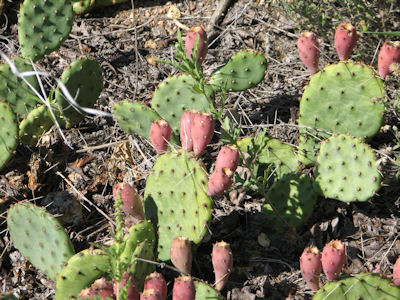
|
| This cactus was found at the Royal Gorge, Fremont county Colorado near
Canon City on 6 July 2010.
Alyssa took the detailed photo of the flower.
It is a cane cholla (or walking stick cholla, tree cholla, chainlink cactus, etc.)
Kingdom: Plantae
Division: Magnoliophyta
Class: Magnoliopsida
Order: Caryophyllales
Family: Cactaceae
Genus: Cylindropuntia
Species: C. imbricata
| 


|















































